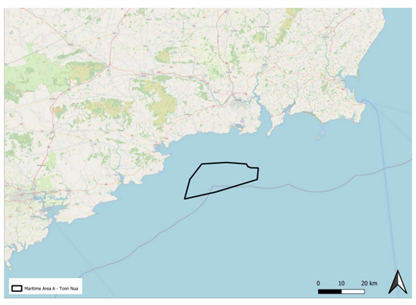Terms and conditions of ORESS Tonn Nua, along with the form of Project Delivery Agreement, Letter of Offer and Performance Security are on the Department of Climate, Energy and Environment’s website here: ORESS Tonn Nua Offshore Wind Auction. Further information, including the auction timetable, is on EirGrid’s website here: RESS | Customer information | EirGrid.
What is being procured?
The auction will select one project to build a Target Installed Renewable Capacity of 900 MW of fixed bottom offshore wind generation capacity off the Southeast coast of Ireland, in the Tonn Nua area of the South Coast Designated Maritime Area, shown below.

It is a requirement that operation and maintenance services will be primarily provided from a port in Ireland or Northern Ireland.
Installed Renewable Capacity must be at least 90%, and no more than 120% of 900 MW.
What support will the successful project receive?
As with previous RESS/ORESS auctions, support is structured as a two-way floating feed-in premium, based on the terms of a Power Purchase Agreement (“PPA”) the Generator will enter into with a licensed Supplier.
The Generator will receive a Strike Price based on its Offer Price in the auction, indexed, plus a Grid Cost Adjustment Amount. The Grid Cost Adjustment Amount, calculated annually, is based on Grid Charges (offshore and onshore use of system, connection or other charges) as a proportion of Total Annual Physical Availability of the Project to provide Active Power.
Broadly speaking, when the Single Electricity Market (“SEM”) day-ahead market price is below the Strike Price (and equal to or above zero), the Supplier will receive a Support Payment from the Public Service Obligation (“PSO”) pot up to the Strike Price. Conversely, when the day-ahead market price is above the strike price, the Supplier will pay the upside back to the PSO pot as a Difference Payment.
The Department indicates that the suitability of using the day-ahead market price as the reference price may be reviewed from time to time.
PSO levy
Payments under the PPA, as well as Unrealised Available Energy Compensation (see more below), will be funded through the PSO levy charged to all final customers, “or otherwise as applicable”. The wording in quotation marks is new, raising the question of whether alternative or additional sources of funding are being considered for the future.
How long is the period of support?
The potential period of support is 20 years. This can be eroded to the extent the Support Start Date occurs after the Target Commercial Operation Date.
The Support Start Date is the earlier of the Grid Compensation Start Date (see more below) and the date of Commercial Operation of the Project. The Support End Date is the earliest of: (i) 20 years after the Target Commercial Operation Date; (ii) 20 years after the Support Start Date; and (iii) the date of withdrawal or revocation of the Letter of Offer.
Commercial Operation must be achieved before the Longstop Date, which is 1 January 2037, potentially extendable under mechanisms for managing judicial review and grid delay.
Can a project be taken to the open market?
In ORESS 1, a request could be made to withdraw from ORESS support and take the project to the open market. This option is not included in ORESS Tonn Nua. There are three circumstances in which the successful Applicant – the Generator – may withdraw from ORESS Tonn Nua: a Planning Consent Failure Withdrawal; an Unsuitable Site Conditions Withdrawal; and an Onerous Planning Condition Event Withdrawal (see more below).
The Generator must remain the sole and exclusive owner of the Project until the Support End Date.
At what stage is a Maritime Area Consent (“MAC”) required?
Unlike in ORESS 1, Applicants in ORESS Tonn Nua are not required to already have a MAC in place. They must, however, complete a MAC application and hold it ready for submission to the Maritime Area Regulatory Authority (“MARA”).
The successful Applicant will be required to submit its MAC application no later than five working days after the final auction result. A series of steps is set out to manage potential outcomes to the MAC application. The successful Applicant will receive a Notice of Award if it receives a MAC where the judicial review period has passed without challenge, or the MAC remains in place following the disposal of a judicial review challenge.
How is site risk addressed?
If the Generator determines that there are Unsuitable Site Conditions, it must notify the Minister as soon as practicable and no later than 30 working days. This cannot be done, however, after the earlier of: (i) three years from the date of the Project Delivery Agreement, and (ii) the date on which the Planning Consent application is submitted by the Generator.
Broadly, Unsuitable Site Conditions are conditions that would prevent the Project from achieving Commercial Operation by the Longstop Date or being developed, constructed and/or operated at the site. They also have to be demonstrably and materially different and detrimental to conditions which would be consistent with Standard Industry Practice for proceeding with the development, construction and/or operation of the Project at the site. There are carve-outs for conditions that could reasonably have been anticipated or identified.
Applicants should bear in mind that “the Project” for these purposes is the project with key characteristics as detailed in the Project Information Document to be submitted and updated at various stages.
The Generator must then, within 60 working days, issue a notice confirming either that: (i) it intends to withdraw from ORESS Tonn Nua; or (ii) it will keep the Project in ORESS Tonn Nua and use all reasonable endeavours to mitigate the effects of the Unsuitable Site Conditions.
How is planning risk addressed?
No later than six months after the date in the Notice of Award, the Generator must submit a Planning Consent application.
If there is a Planning Consent Failure Event, the Generator must notify the Minister as soon as practicable and no later than 60 Working days.
The Generator has 60 working days to either withdraw the Project from ORESS Tonn Nua, or to commit to keep it in and use all reasonable endeavours to resolve the Planning Consent Failure Event as soon as practicable.
If the Generator commits to keep the Project in ORESS Tonn Nua, and the Planning Consent has not been decided on by the Planning Consent Longstop, then there is mechanism for the Minister to agree a revised Planning Consent Longstop.
The terms and conditions provide a somewhat similar mechanism in the event of an Onerous Planning Condition Event being notified (a condition that would restrict the Project’s term of operations, installed capacity, or annual output to the extents identified in the terms and conditions).
As regards judicial review, under the Project Delivery Agreement, for each month during which a judicial review challenge exists in respect of the Planning Consent, there is a mechanism to extend the Target Commercial Operation Date, certain Milestone Completion Dates, and the Longstop Date.
There is also a mechanism to extend time for judicial review of consents other than the Planning Consent or MAC, subject to the Generator providing evidence that the judicial review has had a material adverse impact on the critical path of the Project.
How is grid connection risk addressed?
Unlike Phase 1, Tonn Nua is plan-led, with EirGrid responsible for constructing the grid asset. Failure to connect the Project to the grid in time is a considerable project risk.
The terms and condition indicate that, in the event of a delay in grid connection build-out, the Minister may issue a notice extending Project deadline(s). The TSO may also, with prior consent of the Minister, update the Target Grid Delivery Date (which is 1 July 2033).
Extensions of time based on Grid Standstill Date (Planning)
Under the Project Delivery Agreement, “Grid Standstill Date” is a date eight weeks after both the Planning Consent and planning permission for the Connection Assets are in place.
Milestone 5 is the point at which the Generator issues a notice to proceed under its main construction contract. Up to the deadlines for Milestone 5, if the Grid Standstill Date has not occurred, the deadlines for Milestone 5 are pushed out on a day-for-day basis until the Grid Standstill Date occurs. If the Grid Standstill Date has occurred by the deadlines for Milestone 5, and the Grid Delivery Date has been extended by at least a year beyond the Target Grid Delivery Date (1 July 2033), then the Generator must make a case to get an extension to Milestone 5. For example, it must demonstrate that extension of the Target Grid Delivery Date will delay Commercial Operation.
The Grid Standstill Date may be extended while a judicial review challenge exists in respect of the planning consent for the Connection Assets.
Grid Delay Events: Extension of time and compensation
The Project Delivery Agreement provides a mechanism to extend time for the duration of Grid Delay Events. A “Grid Delay Event” is where the Target Grid Delivery Date is updated, or Grid Delivery will not be achieved by the Target Grid Delivery Date. The Generator has to demonstrate that this will prevent the Project from achieving Commercial Operation by the Target Commercial Operation Date (or Longstop Date). However, from the Grid Standstill Date onwards, there are no extensions to the Target Commercial Operation Date under this mechanism.
For Grid Delay Compensation, the Generator must demonstrate that the Fixed Grid Date has occurred, but that the Longstop Date and Grid Delivery have not occurred, and also that the Project has achieved at least the Minimum Installed Renewable Capacity. The Longstop Date is extended for each day on which Grid Delay Compensation accrues.
How is dispatch down risk addressed?
The Project will receive Unrealised Available Energy Compensation, also known as UAEC, for dispatch down (constraints and curtailment), as well as for oversupply.
Community Benefit Fund
As with the previous auction, the Generator must establish a Community Benefit Fund. For each PSO Levy Year, the Generator’s contribution will be €2/MWh (multiplied by the sum of Loss-Adjusted RESS Metered Quantity and Unrealised Available Energy). During the construction phase, the Generator makes “Early Contribution Payments”, which can be offset against later years.
Qualification process: What’s new?
Project Experience
The Applicant must provide a director’s Declaration of Applicant Project Experience confirming that the director has examined the requirements on project experience and project delivery team experience, and that they reasonably believe that the Applicant or one of more of its Related Companies satisfies those requirements.
Required project experience includes at least 12 months continuous experience at each of: (i) the development (design & consenting) stage, and (ii) the operation and maintenance stage, for a project of a similar scale and nature within the 10 years immediately preceding submission of the Application for Qualification.
Required delivery team experience includes that senior members of the Project team have at least 10 years’ experience of: (i) marine projects of a similar scale and nature with experience gained at development and construction stages; (ii) projects of a similar scale and nature (including terrestrial projects) with experience gained at the development and construction stages; and (iii) the Irish planning permission system delivering projects of a similar scale and nature (including terrestrial projects).
Bid Bond
The Bid Bond, which must be made by way of cash deposit, is required to be €20 million.
Project Information Document
A Project Information Document must detail the key characteristics of the Project. New information requirements include anticipated conditions at the Offshore Site and a Gantt Chart showing how the Project will be delivered. It must be accompanied by a director declaration confirming that it is true and accurate, will remain true and accurate as at the date of the Offer, and is based on, and consistent with, the Target Installed Renewable Capacity.
What happens once a Project qualifies to compete in the auction?
Qualified Applicants submit an Offer Price in €/MWh. The maximum offer price that will be considered is to be specified no later than publication of the Auction Information Pack, which is scheduled for 31 October 2025.
The auction takes the form of a simple, sealed bid auction of eligible Offers. Any tie-break is to be resolved using a random index number.
The successful Applicant must submit its application for a MAC no later than five working days after the final auction result. The successful Applicant will receive a Notice of Award once a MAC is in place (as described above). The successful Applicant then executes the Project Delivery Agreement and provides the Performance Security by the date in the Notice of Award. The Performance Security is €80 million during a First Period, €100 million during a Second Period, and €120 million during a Third Period ending seven months after the Commercial Operation Date or Longstop Date (as may be extended).
No later than six months after the date in the Notice of Award, the successful Applicant submits the initial Project Delivery Plan Questionnaire, applies for full grid connection offer, and submits a planning consent application and updated Project Information Document.




